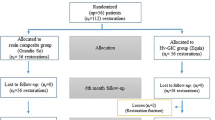Abstract
Objective
To evaluate the long-term clinical performance of heat-cured high-viscosity glass ionomer (GIC) and posterior composite resin (CR) restorations in primary molars over a 3-year period.
Methods
Photographs and radiographs of EQUIA GIC and Filtek™ P60 restorations were assessed. Study sample is comprised of healthy preschool/school children with proximal surface caries in primary molars.
Results
70 GI restorations were placed in 45 patients (aged 78 months ± 25) and were evaluated at 33 months ± 7. 61 composite resin restorations were placed in 42 patients (age 82 months ± 19) and were evaluated at 39 months ± 13. GI restorations failure was 17.1%, a significantly greater rate compared with 4.9% in the CR group. GI failures were due to either significant loss of the restoration or to loss of marginal ridge integrity. CR failures were due to loss of marginal ridge integrity.
Conclusion
Both GI and CR restorations were clinically successful during a 3-year period. GI restorations may be considered as an intermediate-lasting restoration option for proximal lesions in primary molars, with 83% of the restorations functioning up to 36 months. CR restorations showed a higher success rate than GIC during the same period.


Similar content being viewed by others
References
Algera TJ, Kleverlaan CJ, De Gee AJ, Prahl-Andersen B, Feilzer AJ. The influence of accelerating the setting rate by ultrasound or heat on the bond strength of glass ionomers used as orthodontic bracket cements. Eur J Orthod. 2005;27:472–6.
Chan KHS, Mai Y, Kim H, Tong KCT, Ng D, Hsiao JCM. Review. Resin Compos. Fill. Mater.. 2010;3(2):1228–43. https://doi.org/10.3390/ma3021228.
Daou MH, Tavernier B, Meyer J-M. 2-year clinical evaluation of three restorative materials in primary molars. J Clin Pediatr Dent. 2009;34:53–8.
Fabián Molina G, Cabral RJ, Mazzola I, Brain Lascano L, Frencken JE. Biaxial flexural strength of high-viscosity glass-ionomer cements heat-cured with an LED lamp during setting. Biomed Res Int. 2013;2013:838460.
Gavic L, Gorseta K, Glavina D, Czarnecka B, Nicholson JW. Heat transfer properties and thermal cure of glass-ionomer dental cements. J Mater Sci Mater Med. 2015;26(10):249.
Gorseta K, Glavina D. Thermo-cured glass ionomer cements in restorative dentistry. J Istanb Univ Fac Dent. 2017;51(3 Suppl 1):122–7.
Gupta SK, Saxena P, Pant VA, Pant AB. Release and toxicity of dental resin composite. Toxicol Int. 2012;19(3):225–34.
Kleverlaan CJ, van Duinen RN, Feilzer AJ. Mechanical properties of glass ionomer cements affected by curing methods. Dent Mater. 2004;20(1):45–50.
Knight GM, McIntyre JM, Craig GG, Mulyani Zilm PS, Gully NJ. An in vitro investigation of marginal dentine caries abutting composite resin and glass ionomer cement restorations. Aust Dent J. 2007;52:187–92.
Nedeljkovic I, Teughels W, De Munck J, Van Meerbeek B, Van Landuyt KL. Is secondary caries with composites a material-based problem? Dental Mater. 2015;31:e247–77.
Pinto Gdos S, Oliveira LJ, Romano AR, Schardosim LR, Bonow ML, Pacce M, Correa MB, Demarco FF, Torriani DD. Longevity of posterior restorations in primary teeth: results from a paediatric dental clinic. J Dent. 2014;42(10):1248–54.
Roumanas ED. The frequency of replacement of dental restorations may vary based on a number of variables, including type of material, size of the restoration, and caries risk of the patient. J Evid Based Dent Pract. 2010;10:23–4.
Scholtanus JD, Huysmans MCDNJM. Clinical failure of class-II restorations of a highly viscous glass-ionomer material over a 6-year period: a retrospective study. J Dent. 2007;35:156–62.
Song JW, Chung KC. Observational studies: cohort and case-control studies. Plast Reconstr Surg. 2010;126:2234–42.
Tal E, Kupietzky A, Fuks AB, Tickotsky N, Moskovitz M. Clinical performance of heat-cured high-viscosity glass ionomer class ii restorations in primary molars: a preliminary study. J Clin Pediatr Dent. 2017;41:264–70.
Towler MR, Bushby AJ, Billington RW, Hill RG. A preliminary comparison of the mechanical properties of chemically cured and ultrasonically cured glass ionomer cements, using nano-indentation techniques. Biomaterials. 2001;22:1401–6.
Tseveenjav B, Furuholm J, Mulic A, et al. Survival of extensive restorations in primary molars: 15-year practice-based study. Int J Paediatr Dent. 2018;28:249–56.
van Duinen RN, Shahid S, Hill R, Glavina D. In-vitro study on temperature changes in the pulp chamber due to thermo-cure glass ionomer cements. Acta Stomatol Croat. 2016;50(4):287–91.
Author information
Authors and Affiliations
Corresponding author
Ethics declarations
Compliance with ethical standards
Ethical approval
All procedures performed in studies involving human participants were in accordance with the ethical standards of the institutional and/or national research committee and with the 1964 Helsinki Declaration and its later amendments or comparable ethical standards.
Additional information
Publisher’s Note
Springer Nature remains neutral with regard to jurisdictional claims in published maps and institutional affiliations.
Rights and permissions
About this article
Cite this article
Kupietzky, A., Atia Joachim, D., Tal, E. et al. Long-term clinical performance of heat-cured high-viscosity glass ionomer class II restorations versus resin-based composites in primary molars: a randomized comparison trial. Eur Arch Paediatr Dent 20, 451–456 (2019). https://doi.org/10.1007/s40368-019-00423-x
Received:
Accepted:
Published:
Issue Date:
DOI: https://doi.org/10.1007/s40368-019-00423-x




